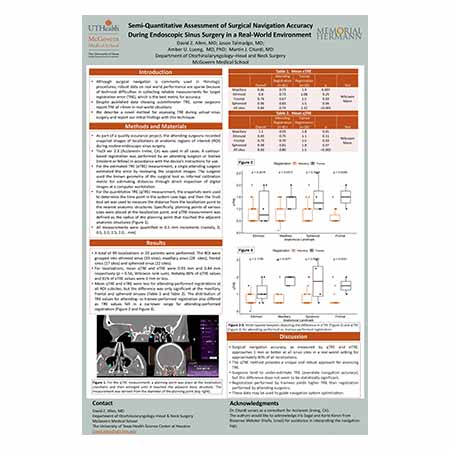Assessment of Surgical Navigation Accuracy During Endoscopic Sinus Surgery in a Real-World Environment
 Although surgical navigation, which often is compared to a GPS-like view of a patient’s nose and sinuses, is commonly used in sinus and skull base procedures, there are little robust data on its actual performance in the operating room. The best metric for measuring its accuracy is target registration error (TRE), which is difficult to calculate during actual surgery.
Although surgical navigation, which often is compared to a GPS-like view of a patient’s nose and sinuses, is commonly used in sinus and skull base procedures, there are little robust data on its actual performance in the operating room. The best metric for measuring its accuracy is target registration error (TRE), which is difficult to calculate during actual surgery.
“For surgical navigation, we need to map corresponding points on the patient and points on the preoperative imaging set through a process known as registration,” says Martin J. Citardi, MD, professor and chair of the Department of Otorhinolaryngology and vice dean for technology at UTHealth Houston. “The ideal registration accuracy is less than 1 millimeter, but the real-world accuracy of surgical navigation systems seems to be greater than 1.5 millimeters. Getting an accurate alignment for registration is difficult, and there is remarkably little published about how accurate these systems are in the real world. In practice, some surgeons report TRE of greater than 3 millimeters.”
Dr. Citardi and his research team aimed to create a semi-quantitative accuracy measure of a surgical navigation system in the real world. Using TruDi version 2.3 from Acclarent, the surgeons recorded snapshot images at anatomic regions of interest during routine endoscopic sinus surgery. For the TRE measurement, a single attending surgeon estimated the error by reviewing snapshot images. The images were also used to mark time points in TruDi’s case log, which was later reviewed for an independent calculation of TRE.
The top-line finding of this study is that 80% of localizations produced TRE values that were less than 1 mm—considerably better than prior reports. In addition, attending surgeons consistently had better TREs than resident surgeons. Lastly, mean TRE at all subsites was below 1.5 mm and thus confirmed consistent system accuracy throughout the sinus space.
“The system performed remarkably well – and better than surgeon expectations and what we have seen published in the literature,” Dr. Citardi says. “We noted that people who are experienced at the registration step do better than novices. In practice, the person who does the registration is, often the least experienced in the room. This result is reproducible – we’ve shown it more than once in prior studies. We believe we can train surgeons to perform the registration step more accurately. It also may be possible to use these observations to optimize system design for a better registration process.”
Another important takeaway for us is that as surgeons we tend to overestimate our accuracy, when in reality we’re not as accurate as we think we are,” he adds. “This, too, has implications for training.”
The research was presented by David Z. Allen MD, postgraduate year 4 resident, at the American Rhinologic Society (ARS) meeting held in Boston.